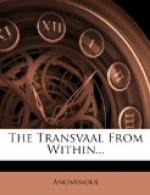Three events of importance marked the year 1897 in the history of the Transvaal. The first was the High Court crisis in February; the second, the appointment of the Industrial Commission of Inquiry; the third, the Queen’s Record Reign celebration.
The High Court crisis arose out of the case of Brown v. The State, already referred to.{46} Brown had acted within his legal rights according to the terms of a proclamation. That proclamation had been illegally withdrawn, and the Government realizing that they would have to stand the consequences of their action in the courts of the country, introduced a law which was immediately passed by the Volksraad, absolving them from all liability, and practically non-suiting all claimants. Mr. Kotze in his judgment declared this law to be improper and in conflict with the Constitution, and gave judgment in favour of Brown, but left the amount of damages to be determined later after hearing further evidence.{47}
The first Volksraad was then in special session, and the President promptly introduced a law known as Law 1 of 1897, which empowered him to exact assurances from the judges that they would respect all resolutions of the Volksraad as having the force of law and declare themselves not entitled to test the validity of a law by its agreement or conflict with the Constitution; and it further empowered the President in the event of his not being satisfied with the character of the replies to summarily dismiss the judges. The judges protested in a body that they would not submit to such treatment. The High Court was adjourned and all legal business was stopped. Particularly emphatic was Mr. Justice Gregorowski. He stated that no honourable man could possibly sit upon the Transvaal Bench as long as Law 1 of 1897 remained upon the Statute Book. At this juncture Sir Henry de Villiers, Chief Justice of Cape Colony, came to Pretoria for the purpose of effecting a compromise and averting a crisis. The compromise was practically an armistice. The judges promised not to exercise the testing right pending the speedy introduction of a measure safeguarding the independence of the courts. Mr. Kruger on his side promised to refrain from enforcing the provisions of Law 1 of 1897, and undertook to introduce as speedily as possible the required new law.




